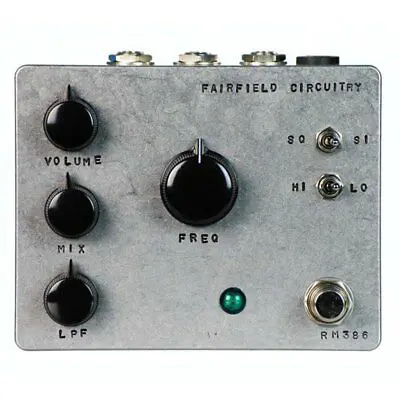Hailing from Hull, Quebec Canada, pedal manufacturer Fairfield Circuitry specializes in edgy stompboxes. The company’s founder, Guillaume Fairfield, is a very talented designer and a pleasure to deal with. Check out my review of his Four Eyes Fuzz here. The subject of this review is his highly coveted ring modulator pedal, Randy’s Revenge. I will say that I don’t always understand his naming scheme, but who cares, he makes great stuff.
Ring Modulation is the result of the multiplying of two signals, where one is typically a sine wave or another simple waveform. The sounds born out of it are in most cases atonal and drastically different from the source. Randy’s Revenge takes this concept much further and implements not one but two simple waveforms – square and sine. Also, the oscillator can be used in two frequency ranges – hi and lo. Another interesting addition is the 12dB/Octave filter that comes after the signals have been multiplied and only affects the wet signal. There is a Mix knob that allows you to dial in just the right balance of wet versus dry. All of these elements combined make for one beautifully articulated ring mod pedal.
On top of this, there’s another big time bonus: the wealth of control voltage (CV) options this pedal has on tap. It has one TRS (stereo 1/4″) CV input that can not only accept a standard expression pedal signal, but can also be split to accept two mono CV inputs using a Y-cable. The functions of the CV input are governed by a set of dip switches found inside the pedal. These functions are defined by the helpful programmer’s guide found on the pedal’s product page. Some of the other options include using the pedal as a voltage controlled oscillator/filter combined or discretely. Check out this little chart below to see other combinations.
In practice, this pedal is one of the more tonally rich than any of the other ring mods I have ever heard. This might be the result of smart circuit design, quality components across the board, and wise feature implementation – or all of the above. I tested it primarily on bass guitar with lots of delay and got smashing results. However, I also ran my monophonic analog synth and guitar through it and it passed with flying colors across the board. I was impressed with the amount of headroom it had, probably due to the JFET input stage. You can run pretty much anything that makes sound through it as a carrier. It was nice to be able to run guitar with dirt through it without artifacts. I highly recommend using an expression pedal to control the Frequency, because that’s what it takes to get the real deal ring mod experience. Add a little delay and you are making sounds from outer space in no time.
That said, ring mods are usually considered a “special effect” – it’s not going to work for every situation – but if you want ring mod, this is the one. It actually sounds the most musical out of any that I’ve had the pleasure of using. The added low pass filter is really nice for crafting interesting tones. It’s really fun to be able to control both filter and frequency with the expression pedal too. Gosh, I just can’t say enough about this one. It’s truly magical. – Gus Green
The Fairfield Circuitry Randy’s Revenge is featured in our guide to the Best Ring Modulator Pedals.
























